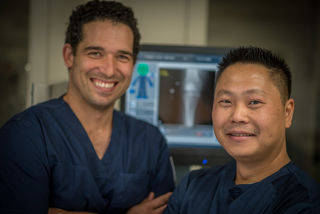Education
New Collar Jobs Are New Pathways to Employment
Closing the skills gap no longer requires advanced degrees.
Posted December 4, 2018
As the United States continues to recover from the worse recession, economic growth is hindered because the skills of today's workers have not kept up with the requirements of current and future jobs. In the United States, the skills and training of today's job seekers often don't match the experience required for specialized jobs in the emerging economy; this is the skills gap we are struggling to close.
A report by the Manufacturing Institute found that nearly 3.5 million U.S. manufacturing job opportunities will be open over the next decade. However, the skills gap will leave 2 million of these jobs vacant.
In August 2018, there were 7.1 million job openings and 6.2 million unemployed people looking for work. According to the Business Roundtable, "American businesses are facing an unprecedented challenge: the labor force simply doesn't have enough qualified workers. In fact, the labor force doesn't have enough workers period." The skills gap is the effect of educational systems not keeping pace with business and the developing economy. Closing the skills gap can only be done by partnering with education.

Business and industry leaders believe that education is the bridge to eliminating the gap. Higher academic standards, better tracking of student performance, and educational programs at all levels must align with the needs of the modern economy. Companies from across the country recognizing this need are partnering with career technical education, community colleges, and universities to create opportunities for on-the-job training, internships, and apprenticeship programs, all to increase qualified job applicants that build the skills required for 21st-century jobs.
Companies like Accenture, Aon and IBM realize that there is a new pathway to employment without an advanced degree. So-called "New Collar" jobs, positions that require specific skills, but not a bachelor's degree, are in high demand. The skills gap, where jobs stay vacant for lack of qualified applicants, has provided opportunities for people who take the initiative to train for desired skills that put them into the workforce. Below are a few active programs;
Accenture
Accenture is working to close the skills gap in computer science. According to Accenture, there were 500,000 open computing jobs in the United States in 2015, but fewer than 40,000 new computer science graduates. Accenture will invest $1.4 billion in training and internship programs for its U.S. people while creating 15,000 highly skilled new jobs. The centerpiece of the investment is Accenture Connected Learning, which includes 37,000 online courses and 2,300 learning boards, online forums curated by subject-matter experts that provide employees with anywhere, anytime development opportunities from design thinking to artificial intelligence, including opportunities for certification in areas such as project management and data science.

Skills to Succeed at Accenture
In communities across the United States, Accenture teams with nonprofits through its Skills to Succeed initiative, advancing employment and entrepreneurship opportunities for individuals. Skills to Succeed includes multiple programs focused on veterans and military families. In partnership with Syracuse University, Accenture has developed the Institute for Veterans and Military Families. Along with the Accenture Veteran Technology Training Program, Accenture has equipped more than 6,000 military-connected members with the skills, coaching, mentoring, and placement services to help them successfully transition to the civilian workforce.
In Chicago, Accenture is partnering with Wilbur Wright College, which houses the City Colleges’ Center for Excellence for IT, where Accenture has taken an active role in enhancing and shaping the information technology and cybersecurity curriculum. In Texas, through an internship program, Accenture is working with San Antonio’s Eastside Education and Training Center, Sam Houston High School, and Alamo Colleges, enabling young people from disadvantaged communities to build the skills necessary for entry-level jobs in industry. In 2016, Accenture reskilled over 11,000 people in new IT areas and in fiscal 2017, they more than doubled that number to approximately 25,000.
Participants receive more than 45 hours of training and development each year. In 2017, the summer internship program had more than 450 college student interns across 26 locations. Approximately 90 percent of Accenture interns become full-time employees when they graduate. Through Skills to Succeed, Accenture has equipped nearly 400,000 people in the United States with employment and entrepreneurship skills.
Aon Power Results
Aon has launched its inaugural U.S. Apprenticeship Program, a two-year program in coordination with City Colleges of Chicago. Apprentices gain professional experience as paid, full-time colleagues. Aon works with City Colleges to train and provide the skills the workers of the future need most, thus creating a viable job pathway for students. Recruiting and hiring are often most difficult in entry-level positions where retaining employees with the right skills can be challenging.
From the perspective of prospective workers, the cost of college creates either a barrier to entry to a career job or student loan debt that impairs a healthy financial future. The Aon Apprenticeship Program works to address this issue head-on. The Apprenticeship Program signifies the evolution of talent strategy: Aon is connecting with a wider pool of prospective colleagues earlier in their careers and cultivating future talent through on-the-job training and development that is specific to Aon’s roles and business objectives. The apprentices are able to gain valuable experiences in the areas of account management, client support, financial analysis, Human Resources, and information technology. Ultimately, this program increases productivity and fills the need for a talent pipeline for roles that do not require a four-year bachelor’s degree.
Aon works in partnerships with Harold Washington and Harper Colleges to implement the apprenticeship program. Aon will hire 25 apprentices each year for the next four years. Harper College and Harold Washington College have worked with Aon to create a specialized curriculum for Aon apprentices to take classes on campus. Upon completion of the apprenticeship program, graduates will obtain an associate degree in business, an industry apprenticeship accreditation, and a full-time position at Aon. The apprenticeship program provides unique attention and support to individual apprentices from both a professional development and an academic perspective. Apprentices are full-time Aon employees who work downtown at the Aon Center or in Aon’s Lincolnshire office in Illinois. In addition to comprehensive on-the-job training, work experience, and mentorship, apprentices receive a competitive salary and full employee benefits; paid tuition at partner schools; leadership exposure; and a full-time job offer upon completion of the apprenticeship program.

IBM
IBM uses the phrase, “No Degree? No Problem!” in advertising their Apprenticeship Program. IBM’s New Collar Jobs campaign addresses the high-tech skills gap by emphasizing job roles that prioritize capabilities over credentials. IBM’s approach to the skills gap is to work through a wide range of skills development and education initiatives. IBM also calls on policymakers to expand the number of career-oriented training pathways that students and mid-career professionals can access to build New Collar career skills.
At any given time, IBM has thousands of job openings in the United States, and like others in the industry, they cannot find enough candidates with the right mix of in-demand technology skills to fill them. These New Collar jobs are recognized as roles in some of the technology industry’s fastest-growing fields, from cybersecurity to digital design, that require technical training or some postsecondary education but not necessarily a four-year degree. IBM is advocating for New Collar skills through 21st-century vocational training, innovative public education programs like P-TECH, coding camps, apprenticeships, professional certification programs, and more.
IBM pioneered P-TECH, a new education model that couples academics with hands-on skills training and science, technology, engineering, and math (STEM) community college degrees to put graduates first in line for job interviews. Students graduate in six years or less armed with a high school diploma and a no-cost, two-year associate degree in a growth industry field. IBM’s Veterans Employment Initiative provides software training, certification, and job placement assistance to veterans pursuing careers as data analysts. With funding from the Department of Labor, IBM is working with North Carolina A&T on recruiting women and people of color for an enterprise computing/mainframe apprenticeship. IBM has pledged to hire 25,000 people in the United States through 2020, many in New Collar roles. According to IBM, this pledge also includes a commitment to hire 2,000 veterans of America’s armed forces, many into New Collar positions. Over the next four years, IBM is investing $1 billion in training and development programs for its U.S. workforce. According to Ginni Rometty, Chairman, President, and CEO of IBM Corporation, “We are advocating for legislation to better match U.S. career and technical training with New Collar career paths, including renewal and expansion of the Carl D. Perkins Career and Technical Education Act, financial aid for short-term credentials like coding camps, expansion of federal work-study programs, summer Pell programs, and more. With more than 60 schools worldwide, the P-TECH model is being replicated successfully while helping students prepare for New Collar careers.” Three members of the original P-TECH class in Brooklyn graduated high school with two-year college degrees and started jobs at IBM with salaries of more than $50,000 per year. Under the New Collar Initiative at IBM’s U.S. facilities, as many as one-third of their employees have less than a four-year college degree. In fact, New Collar candidates without a four-year degree accounted for approximately 15 percent of all IBM hiring in the United States.
New Collar jobs are positions that employers in many industries demand but remain largely unfilled. To create New Collar jobs, industry must engage in collaboration with state and federal governments, K-12, community colleges, and private businesses across the industry. These types of partnerships will be instrumental in closing the skills gap and putting people to work.
References
Bureau of Labor Statistics, The Employment Situation- July 2018, https://www.bls.gov/news.release/pdf/empsit.pdf
Bureau of Labor Statistics, Occupational Statistics - July 2018, https://www.blsgov/emp/tables/emp-by-major-occupational-group.htm
Business Roundtable, Work in Progress, (June 2017), https://www.businessroundtable.org/sites/default/files/immigration_repo…
Laboissiere, M. & Mourished, M. (February, 2017). Closing the Skills Gap: Creating Workforce-Development Programs that Work for Everyone, MickKinsey & Company, https://www.mckinsey.com/industries/social-sector/our-insights/closing-….
The Skills Gap in U.S. Manufacturing 2015 and Beyond, http://www.themanufacturinginstitute.org/ `/media/827DBC76533942679AI5EF7067A704CD.ashx
Work in Progress: How CEOs Are Helping Close America's Skills Gap (June, 2017), https://s3.amazonaws.com/brt.org.BRT-SkillsGap201711012017(1).pdf




